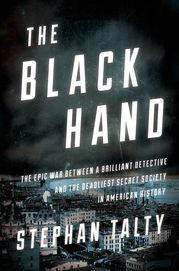Terror 100 Years Ago

The last time so many Americans were in such a tizzy about immigration was more than a century ago, when waves of Italians were crashing upon the nation’s shores. They hailed from southern Italy mostly and were fleeing poverty and oppression.
A few were also on the lam. Before the Mafia captured the American crime spotlight in the 1920s, there was the Society of the Black Hand, which made ends meet by terrorizing and extorting fellow Italians, mainly, among them tenor Enrico Caruso and Italian-American business owners. The Black Hand even targeted Mafiosi in New York and Chicago — not exactly easy pickings.
Oftentimes a threatening letter and a coal-blackened handprint on a victim’s door did the trick. Kidnapping, murder, arson and dynamite were other calling cards of this malevolent organization.
Waxing ever more brazen, the Black Hand diversified in early 20th century America. It began threatening native-born citizens, including John D. Rockefeller’s granddaughter, baseball player Frank Chance, and, of all people, Daniel Wesson, owner of Smith & Wesson.
In "The Black Hand: The Epic War Between a Brilliant Detective and the Deadliest Secret Society in American History," author Stephan Talty’s mission is twofold: plumbing the darkness of this shadowy society and reviving the legend of its nemesis, New York City policeman Joseph Petrosino.
Dubbed the "Italian Sherlock Holmes” and himself an immigrant, Petrosino battled the Black Hand with his fists and his wits. A more contemporary nickname might be “Dirty Harry.” When a conviction proved elusive, he and fellow officers on his famed “Italian Squad” were apt to prescribe the “nightstick cure.”
Lost in the haze of history, Petrosino was once a nationally known character straight out of central casting — indeed, Leonardo DiCaprio is slated to play him in a movie based on this book. In 1895, Teddy Roosevelt, then New York City Police Commissioner, promoted Petrosino to lieutenant, and in 1901 President William McKinley tapped him to infiltrate an anarchist group thought to be involved in the assassination of King Umberto I of Italy. Petrosino’s subsequent warning that McKinley was on the group’s hit list was ignored: an anarchist did, in fact, assassinate the president later that year.
Talty succeeds in vividly portraying Italian-American mores at the dawn of the 20th century, and his well-researched account is replete with anecdotes of mayhem, terror and heroism.
Petrosino’s steadfast bravery will require no Hollywood embellishment. A newspaper reporter once observed the detective singlehandedly collaring a suspect who was dining with a coterie of armed thugs; as he literally hauled his man in, the short, stocky detective roundly slapped him about for good measure.
Where the author falls short is in not addressing how concern over the Black Hand directly influenced subsequent legislation restricting immigration.
Nor does Talty comment on what readers today might learn from an earlier time when immigration was an important political issue. Were restrictions warranted? Did they make America a better, safer place? This seems a lost opportunity.